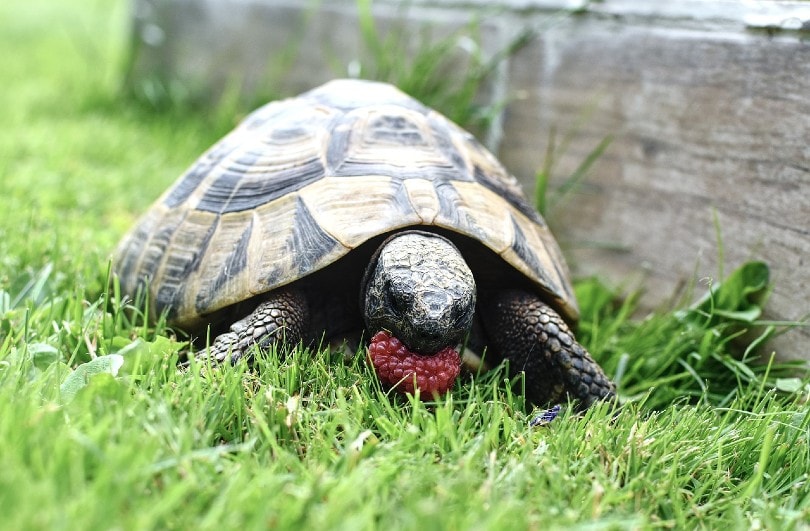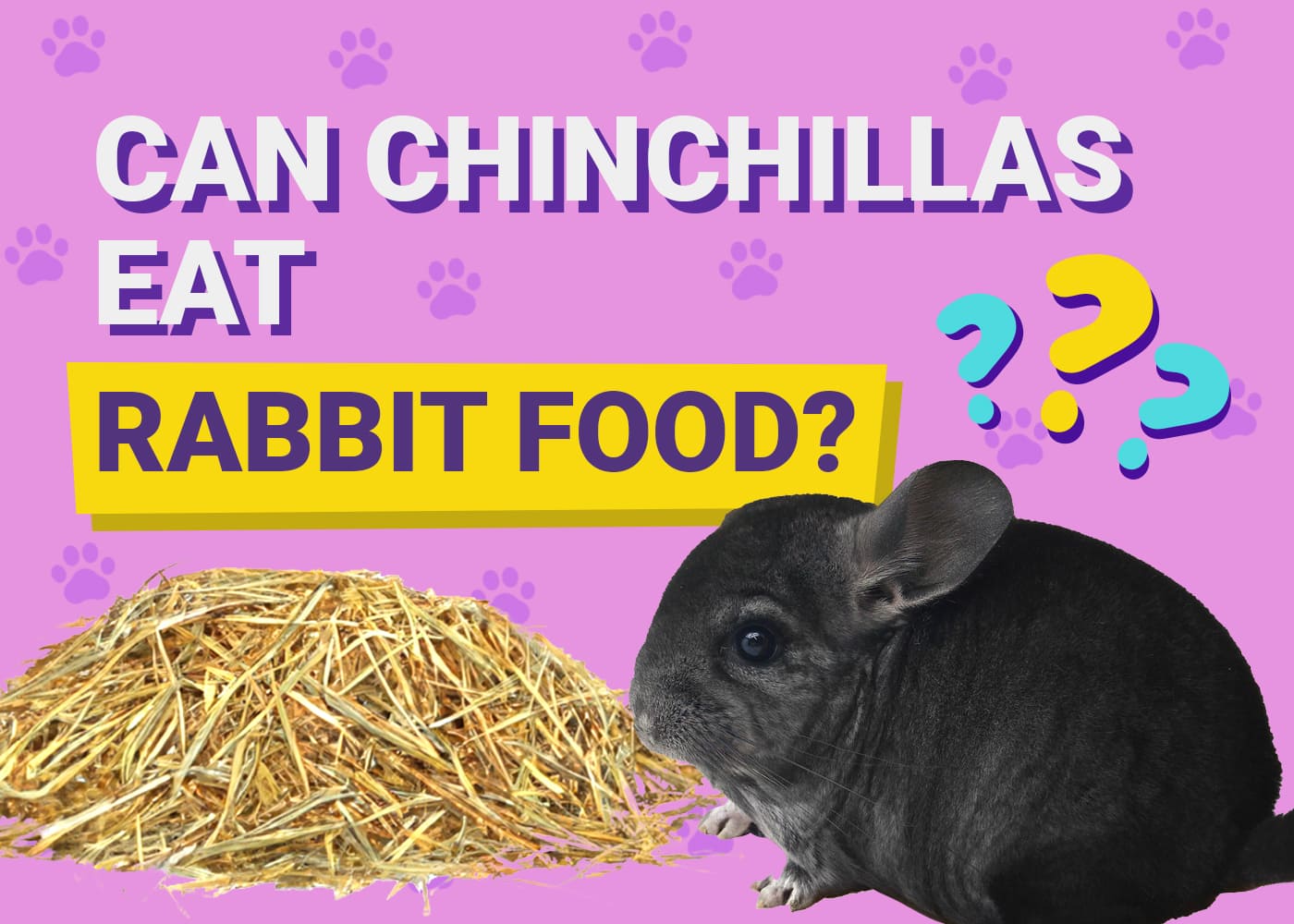Click to Skip Ahead
A tortoise’s diet depends entirely on their species and the part of the world that they come from. Knowing these details will help you determine what your particular tortoise eats in the wild and as a pet.
Let’s start by looking at the natural habitats and eating habits of different species of tortoises in various parts of the world and what they should be fed when kept as pets. We also discuss supplements and how often you should feed your pet tortoise so they can live a long and healthy life.

Tortoise or Turtle?
First, let’s go over the differences between a tortoise and a turtle, as there’s usually a lot of confusion between the two. Knowing what kind of animal you have significantly impacts what you should feed them.
| Turtle | Tortoise | |
| Legs | Flipper-like | Stocky |
| Feet | Webbed | Stumpy, elephant-like |
| Diet | Omnivore | Herbivore |
| Habitat | Land and water | Land only |
| Shell | Thin and flat | Domed and rounded |
Turtles are semi-aquatic reptiles that are also omnivores, so they typically require more protein than vegetarian tortoises. They will eat small fish and insects and specially-made food that’s high in protein for those turtles that are kept as pets.
What Wild Tortoises Eat
Now that you have a basic understanding of the differences between these two related reptiles, let’s get into the habitats and diets of a few of the different species of wild tortoises. Understanding what they eat in the wild will give you a much better idea of what you can feed a pet tortoise.
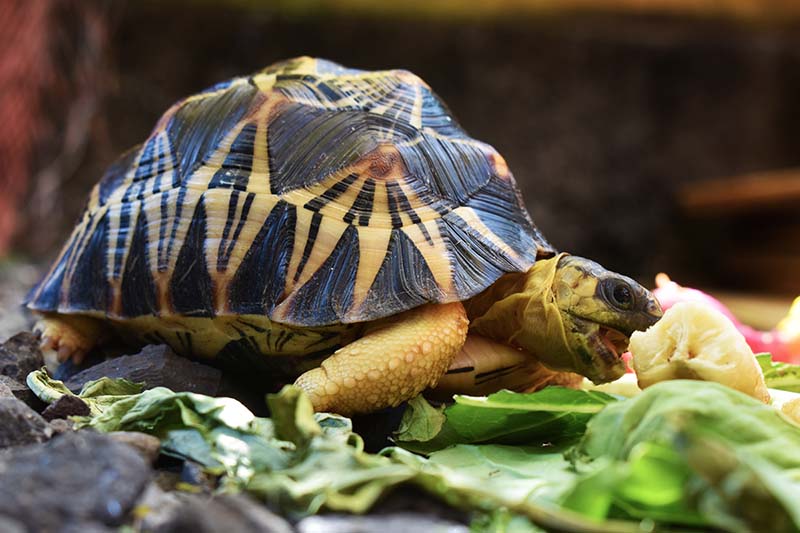
Mediterranean Tortoises
There are a number of tortoises that come from the arid countries surrounding the Mediterranean Sea. These are some of the most popular tortoises kept as pets.
- Greek or Spur-Thighed Tortoise: Native to North Africa, southern Europe, and southwest Asia in semi-arid grasslands
- Hermann’s Tortoise: Located around southern Europe; their natural habitat consists of forests with oak and evergreen with scrubby vegetation, grassy hillsides, and arid, rocky slopes
- Russian Tortoise: Commonly found in Russia, Pakistan, Iran, and Afghanistan in rocky deserts
- Marginated Tortoise: Found mainly in southern Italy and Greece in woodland, hillsides, and dry scrub
Mediterranean Tortoises typically inhabit semi-arid grasslands where they graze on weeds, shrubs, and succulents.
Arid/Tropical Tortoises
These tortoises are in tropical regions that are dry and have less choice of food for them to forage from.
- Leopard Tortoise: Comes from central and southern Africa in dry savannas in semi-arid regions
- African Spurred Tortoise: Also known as the Sulcata, found in the grasslands and deserts of northern Africa; known to burrow to escape the heat
- Indian Star Tortoise: Native to Pakistan, Sri Lanka, and India, lives in scrub forests and semi-desert grasslands but might also be found in humid jungles
These tortoises graze on food like grasses, weeds, cacti, stems, leaves, and flowers.
Jungle/Tropical Tortoises
These tortoises are inhabitants of lush and dense rainforests where they can eat a variety of plants and fruit.
- Yellow-Footed Tortoise: These tortoises are found in Brazil, French Guiana, Guyana, Bolivia, Southern Colombia, Peru, Ecuador, and Venezuela and spend time in the undergrowth of the humid tropical jungles.
- Elongated Tortoise: They range across India, Bangladesh, Laos, Cambodia, Nepal, Myanmar, Vietnam, southern China, and parts of Malaysia. They are found in humid, tropical forests and don’t actually bask, as they spend most of their time buried in leaves or at the base of larger tropical plants.
- Burmese Mountain Tortoise: They range from Malaysia, Myanmar, Sumatra, and Thailand. Like the Elongated, they prefer to burrow in the soil and prefer moist, cool temperatures.
- Red-Footed Tortoise: They can be found from Panama to Argentina and throughout South America. These tortoises live in dry and wet forests, grasslands, and savannas.
These animals eat leaves, flowers, fruits, fungi, and grasses, with the occasional amphibian and invertebrate, though this isn’t that common.

Feeding a Pet Tortoise
While almost all tortoises, regardless of where they come from, eat certain kinds of food that are similar, it’s in the best interests of your pet to have their diet closely linked to what their species would eat in the wild.
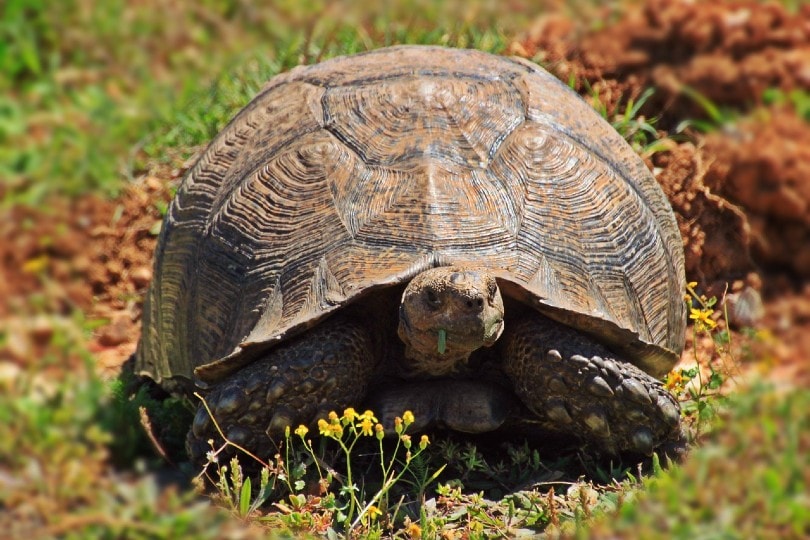
Mediterranean Tortoises
If you have a Mediterranean Tortoise, they will do well with salad greens, such as rocket, kale, and baby leaf mixes. However, avoid lettuce like iceberg, as it doesn’t offer any nutritional value.
- Chicory
- Dandelion
- Coleus
- Sow thistle
- Plantain
- Clover
- Vetch
- Hawkbit
- Shepherd’s purse
- Hedge mustard
- Mallow
- Field bindweed
Just be sure these plants haven’t been sprayed with any chemicals or pesticides—in fact, try to grow your own! You can also serve flowers and succulents, such as prickly pear, as a part of their regular meals. These kinds of leafy greens should make up about 80% of their entire diet.
Veggies like broccoli, cauliflower, peppers, and butternut squash are also good but only serve these once or twice a week. A rare treat of fruit can be fun, but you should only provide it once every few weeks, as it could upset your pet’s digestive system if you give them too much.
- See Also: Can Tortoises Eat Spinach?
- Grapes
- Mangoes
- Strawberries
- Peaches
- Melons
- Pears
- Cherries
Arid/Tropical Tortoises
The tortoises from these regions tend to come from grasslands and savannas, which makes makes them grazers. In fact, they are also known as lawnmowers, as they will happily munch on the grass in your yard. You can also provide them with the same 80% leafy green diet as for the other Mediterranean species.
The Indian Star Tortoise is the only species that will benefit from a small amount of protein. You can offer them a tiny amount of fish or meat once a week to meet their nutritional needs.
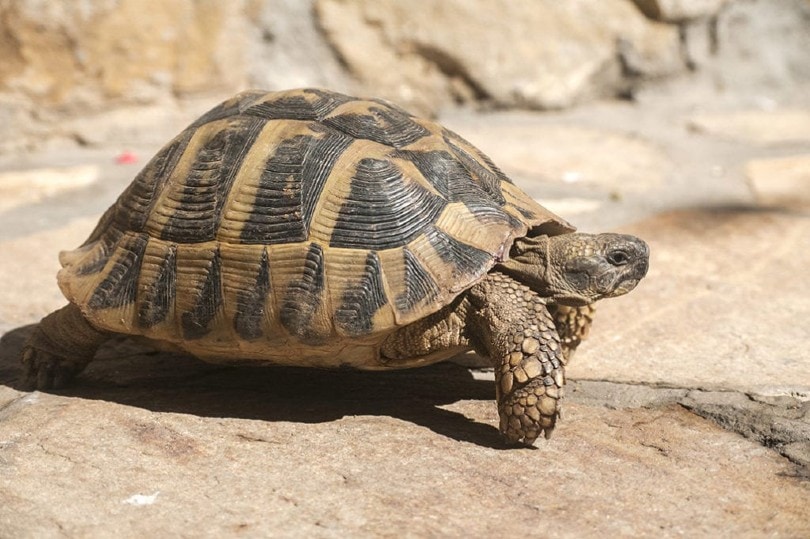
Jungle/Tropical Tortoises
Jungle tortoises can eat the same leafy green vegetables as Mediterranean Tortoises, and these should make up 80% of their diet. The primary difference is that you can serve fruit once or twice a week in addition to other vegetables, such as broccoli and cauliflower.
Since these tortoises live in such moist and humid environments, they are occasionally omnivores and therefore do eat animal material. So, you can add a small amount of protein to their diet but only about once a week.
- Canned fish (not packed in any salt or oil)
- Dog food (high protein and low fat)
- Cooked chicken
- Earthworms
If you can’t grow your own food for your tortoise, consider buying organic. The fewer additives in the food, the better it is for your tortoise’s health. You can also consider purchasing commercially prepared tortoise food, but you should also serve it sparingly. While it does add variety, you shouldn’t depend solely on it.

Water for Tortoises
Water is vital to all tortoises. You might not see your tortoise drink all too often, but it’s essential to leave out a clean, shallow dish with fresh water that is changed every day for your pet.
You should also place your tortoise in a shallow bowl of water about once or twice a week for about 10 to 15 minutes. This will give them a bath and ensure that they can take in any necessary water. Filtered water is best since it will remove the chlorine and metals from tap water.
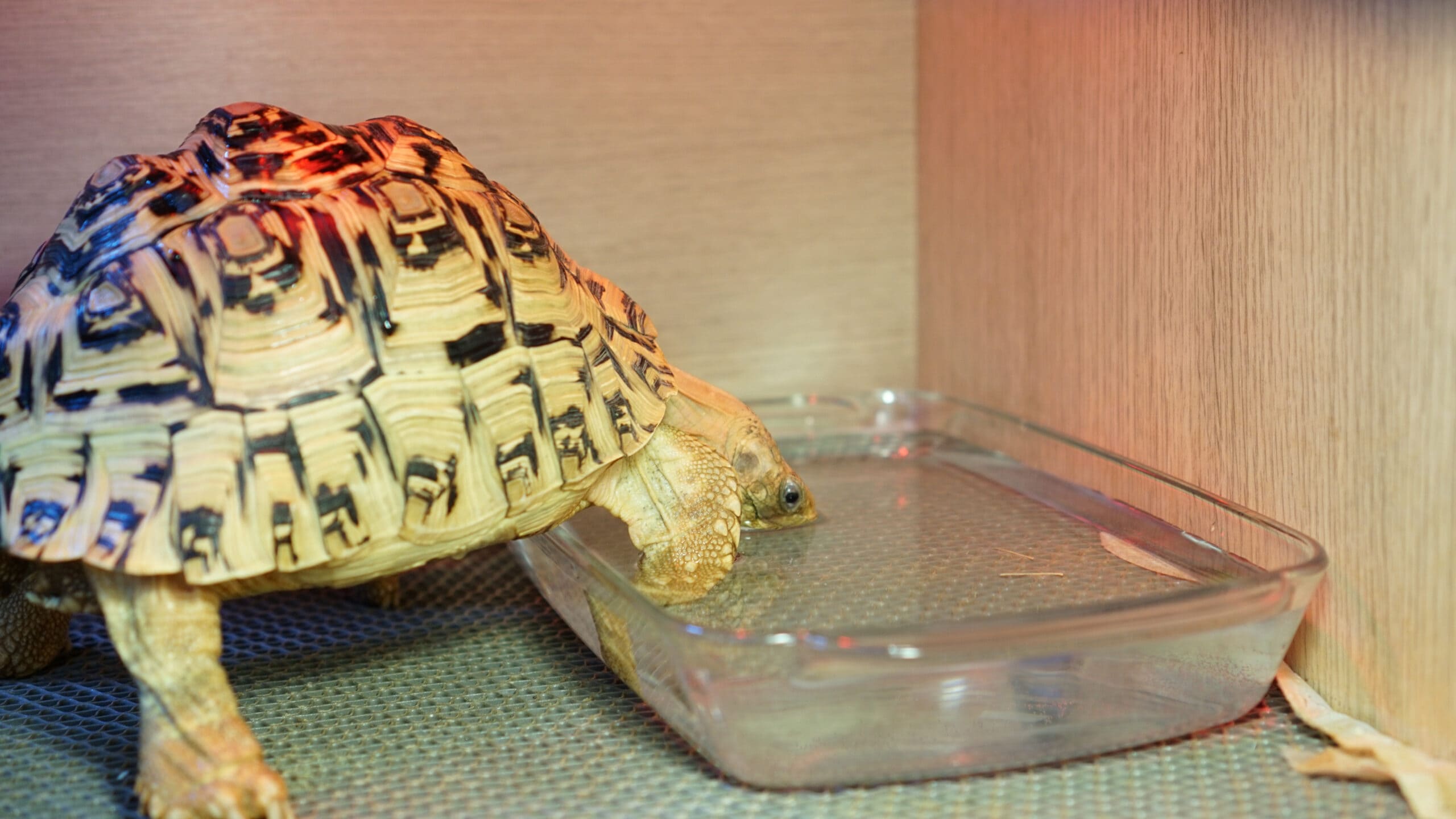
Potentially Dangerous Foods for Tortoises
It’s important to know that there are a number of plants and food that can be harmful to tortoises. When this animal is grazing, they tend to stay away from any plants that are bad for them, but you also need to avoid giving your indoor-only tortoise the following items:
- Foxgloves
- Daffodils
- Buttercups
- Bean sprouts
- Irises
- Wood anemones
- Azaleas
- Avocados
- Auriculas
- Hydrangeas
- Citrus fruits
- Morning glories
- See Also: Can Tortoises Eat Cabbage?
How Much and How Often Should You Fed Your Tortoise?
If your tortoise grazes outside, you don’t have to worry as much about providing them with set meals. If your yard is lush, you won’t need to give your tortoise as many meals as you would an indoor tortoise.
Most tortoises do well with being fed every other day or just three times a week, but this depends on the tortoise. You can also provide your pet with small but nutritious meals every few days and then put them outside to graze.
Just research your tortoise to make sure the food they’re eating is safe, whether they’re indoors or outdoors. This way, you’ll get to know the right amounts and when it’s time to feed your pet. Of course, speak to your vet get advice.
Calcium Supplements
Adding calcium to your tortoise’s food is vital because it helps keep the shell strong and helps maintain excellent health. Just avoid any calcium supplements that are high in phosphorus, as this will stop the calcium from being absorbed into the tortoise’s system.
Your best bet is to add a calcium supplement that includes vitamin D (also important for the tortoise) and doesn’t contain any phosphorus. You can also consider giving your tortoise a cuttlebone or a “tortoise block,” but in the long run, a good calcium powder will be best.
Vitamin D
If your tortoise frequently grazes outside in the sun, they will get a nice amount of vitamin D, but the indoor tortoise will need extra. You can invest in a good UV lamp for your pet’s enclosure so they can bask. If you don’t have calcium with added vitamin D, you’ll need to find a separate vitamin D powder that can also be sprinkled on their food.


Summary
Now you have a better idea of what many tortoises eat, both in the wild and in human homes as pets. If you have a newly acquired tortoise, you need to do your homework and read up on the species that you’ve brought home with you.
Everything about the species and how they interact with their natural habitat will dictate what housing, temperature, and of course, diet your new pet is suitable for and will keep them healthy and happy.
See also:
Featured Image Credit: Susanne Edele, Pixabay
